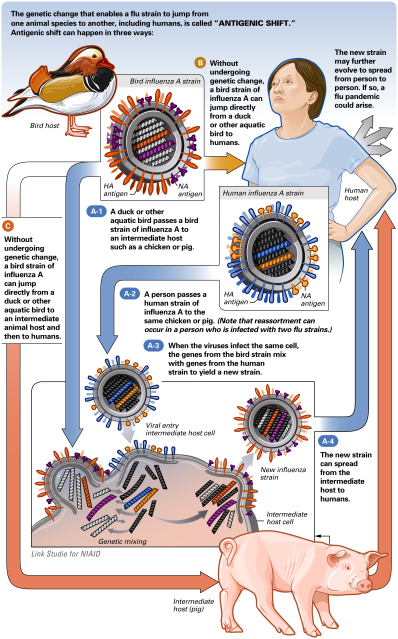

Influence A virus subtype H1N1 is known as A(H1N1) . It is a subtype of influenzavirus A.
Most common in influenza or flu in human.
Some are endemic in Human (occur in human) , less virulent H1nN1 occurs in swine and bird.
Less virulent cause influenze like illness like seasonal flu.
In March, April and May 2009, thousands of laboratory-confirmed infections and a number of deaths were caused by an outbreak of new influence virus subtye called A(H1N1)
Previous deadly and dangerous outbreak include :-
Spanish Flu
1918 outbreak which kill about 50-100 millions of human worldwide. Cause by a subtype of H1N1 influence virus. It unusually severe and part of an avian influenze that mutated and migrate into human.
It cause a cytokinase storm , which basically cause the overstimulate immune system to secrete cytokinase into the lung tissues . This cause the lung to be flooded with fluid and destruction of lung tissues.
It cause difficulty in breathing to human and death.
Russian Flu.
The more recent Russian flu was a 1977–1978 flu .Less dangerous and only infect younger people below 23 years old. Properly because it hit in 1945 era , hence causing the adult have immunity to it. In 1978-79 , it is included influenza vaccine.
2009 Influenza A(H1N1) outbreak
Consist of a mongrel of mixture of 4 types of subtype of influenze flu viruses.North American Mexican influenza, North American avian influenza, human influenza, and swine influenza virus typically found in Asia and Europe.Mixture of human,avian ,swine influence.W.H.O in April 2009 called this new strain as Influence A(H1N1) virus.
Symptoms of Infection.
The symptoms of this new H1N1 flu virus in people are similar to the symptoms of seasonal flu and include fever, cough, sore throat, runny or stuffy nose, body aches, headache, chills and fatigue. A significant number of people who have been infected with this new H1N1 virus also have reported diarrhea and vomiting. The high risk groups for novel H1N1 flu are not known at this time but it’s possible that they may be the same as for seasonal influenza. People at higher risk of serious complications from seasonal flu include people age 65 years and older, children younger than 5 years old, pregnant women, people of any age with chronic medical conditions (such as asthma, diabetes, or heart disease), and people who are immunosuppressed (e.g., taking immunosuppressive medications, infected with HIV).
How to Prevent in Infection to self
The four key things to do that will help in preventing you from getting the H1N1 Flu or Swine Flu:
- 1. Wash Your Hands
2. Cover Your Cough
3. Don't Touch Your Face
4. Stay Away from People Who are Sick
CDC Recommendation
CDC recommends the use of oseltamivir or zanamivir for the treatment and/or prevention of infection with swine influenza viruses.
- * Oseltamivir (brand name Tamiflu ®) is approved to both treat and prevent influenza A and B virus infection in people one year of age and older.
* Zanamivir (brand name Relenza ®) is approved to treat influenza A and B virus infection in people 7 years and older and to prevent influenza A and B virus infection in people 5 years and older.
Check with your physician to find out if you would need to take one of these medications to prevent or treat Swine Flu.





0 comments:
Post a Comment